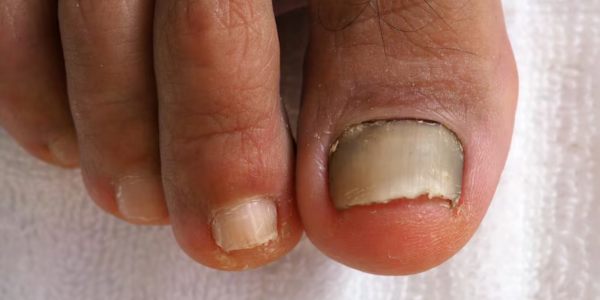Biblical Cure for Toenail Fungus
A Biblical Cure for Toenail Fungus: Ancient Remedies and Modern Insights

Toenail fungus, medically known as onychomycosis, is a common condition that affects millions of people around the world.
It typically starts with a small, unsightly white or yellowish discoloration beneath the toenail and can progress to cause thickening, crumbling, and in some cases, pain and discomfort.
While many people turn to over-the-counter medications and prescription treatments to tackle this issue, an increasing number of individuals are seeking natural and spiritual remedies that are mentioned in ancient texts, particularly the Bible.
In this blog post, we will explore the concept of a “biblical cure” for toenail fungus, diving into natural remedies that may have roots in biblical traditions.
We will also discuss how these remedies are viewed in light of modern medical science, offering a balanced perspective that honors both spiritual beliefs and current health practices.
Understanding Toenail Fungus
Toenail fungus is caused by a fungal infection that enters the nail through tiny cracks or cuts in the skin. The infection can spread rapidly if left untreated and, in severe cases, can cause the toenail to detach from the nail bed.
The fungus thrives in warm, moist environments, which is why toenail fungus is commonly found in people who wear closed shoes for extended periods or who frequent damp areas like swimming pools and locker rooms.
Symptoms of Toenail Fungus Include:
- Discoloration of the nail (yellow, white, or brown)
- Thickening of the nail
- Crumbling or brittle nails
- Foul odor from the infected area
- Pain or discomfort, especially when walking
Common risk factors for toenail fungus include:
- Age (older adults are more susceptible)
- Poor hygiene
- Weakened immune system
- Diabetes or circulatory problems
- Wearing tight-fitting shoes or damp socks
Given that this condition is both common and persistent, it’s not surprising that people often look for alternative ways to treat toenail fungus, some of which may be linked to biblical teachings.
Biblical Perspective on Health and Healing
The Bible does not directly mention toenail fungus, but it offers a wealth of wisdom regarding health and healing. Throughout the Old and New Testaments, the Bible emphasizes the importance of maintaining one’s health and caring for the body.
Many of the principles found in scripture align with modern concepts of hygiene, nutrition, and overall wellness.
Additionally, natural remedies, often derived from plants and oils, were frequently used in biblical times and were considered essential for treating a wide range of ailments.
Healing through Natural Remedies in the Bible:
- Frankincense: One of the most well-known biblical healing substances is frankincense, a resin derived from the Boswellia tree. Frankincense was used in biblical times for various medicinal purposes, including the treatment of infections and inflammation. Its antimicrobial properties make it a relevant candidate in addressing fungal infections.
- Myrrh: Another widely known biblical substance, myrrh, was used for its antiseptic and anti-inflammatory properties. It was often applied to wounds to prevent infection, making it an ideal candidate for supporting skin and nail health.
- Olive Oil: Olive oil is mentioned many times in the Bible, not only as a food source but also as a means of healing. Its antioxidant and moisturizing properties can promote skin health and potentially assist in alleviating fungal infections.
- Aloe Vera: While aloe vera is not directly mentioned in biblical texts, its widespread use in ancient cultures makes it likely that it was used for treating skin conditions, including fungal infections. Aloe vera has been shown to have antifungal properties and is often used to soothe and moisturize irritated skin.
Biblical Lessons on Healing: In addition to the direct use of natural substances, the Bible also teaches principles related to spiritual healing, such as faith, prayer, and seeking wisdom.
For example, James 5:13-15 says, “Is anyone among you sick? Let them call the elders of the church to pray over them and anoint them with oil in the name of the Lord.”
This passage emphasizes the importance of both spiritual and physical healing, suggesting that prayer and the use of healing oils work together.

Natural Remedies for Toenail Fungus Based on Biblical Principles
Several natural remedies that align with biblical healing traditions may be beneficial in managing toenail fungus.
While these remedies are not a substitute for medical treatment, they can be used in conjunction with conventional methods to support healing.
Below are some potential biblical-inspired remedies that could help in the fight against toenail fungus.
1. Frankincense Oil
Frankincense essential oil is widely recognized for its potent antifungal, anti-inflammatory, and antimicrobial properties. In biblical times, frankincense was often burned as incense for religious ceremonies, but its healing qualities have been well documented throughout history.
Frankincense oil can help reduce the fungal growth that causes toenail fungus, as it has the ability to penetrate the skin and kill harmful microorganisms.
How to Use Frankincense Oil for Toenail Fungus:
- Mix a few drops of frankincense oil with a carrier oil (like coconut or olive oil) to dilute it.
- Apply the mixture to the infected toenail twice daily.
- Cover with a bandage for extra absorption, or leave it open to air dry.
Frankincense oil’s antifungal properties make it an excellent option for treating toenail fungus. Its anti-inflammatory effects also help reduce swelling and irritation around the infected area.
2. Myrrh Oil
Myrrh oil, like frankincense, has been used for centuries for its medicinal properties. It is particularly known for its ability to promote skin health and act as an antiseptic.
Its antifungal properties make it an excellent choice for combating toenail fungus. Additionally, myrrh oil can help soothe the discomfort associated with fungal infections, such as redness and swelling.
How to Use Myrrh Oil for Toenail Fungus:
- Mix myrrh oil with a carrier oil such as olive oil or jojoba oil.
- Apply a few drops of the mixture directly to the affected toenail.
- Repeat this process twice daily until symptoms subside.
Myrrh oil has antifungal and antibacterial properties, which can help eliminate the infection that causes toenail fungus while also soothing irritated skin.
3. Olive Oil
Olive oil has long been recognized in the Bible for its nourishing properties, both for the body and the skin. Its antioxidant-rich composition can support overall skin health, and it has mild antifungal properties.
Olive oil can also act as a moisturizer, which can prevent the toenail from becoming dry and brittle as it heals from the infection.
How to Use Olive Oil for Toenail Fungus:
- Heat a small amount of olive oil and apply it to the infected toenail with a cotton ball.
- Let the oil soak in for at least 30 minutes before rinsing off.
- For added benefit, add a drop or two of essential oils like tea tree or frankincense to the olive oil for enhanced antifungal action.
Olive oil provides essential moisture to the affected toenail, which can help it heal faster. Additionally, its mild antifungal and antioxidant properties work together to promote skin and nail health.
4. Aloe Vera
Aloe vera is renowned for its soothing and healing properties, making it a great option for managing skin conditions such as fungal infections.
Though not directly mentioned in the Bible, aloe vera has been used for thousands of years in various cultures for treating wounds, burns, and skin irritations. It’s thought to have antifungal properties that can help fight toenail fungus.
How to Use Aloe Vera for Toenail Fungus:
- Cut open an aloe vera leaf and extract the gel.
- Apply the gel directly to the infected toenail.
- Allow the gel to sit for 30 minutes to an hour before washing it off.
Aloe vera’s antifungal properties can help combat toenail fungus while providing much-needed moisture to the affected area. The gel also has anti-inflammatory effects that can reduce swelling and redness around the nail.
5. Essential Oils (Tea Tree, Lavender, and Oregano)
Essential oils like tea tree oil, lavender oil, and oregano oil are often used in conjunction with other treatments to combat toenail fungus.
While not specifically mentioned in the Bible, these oils have been used for centuries for their antimicrobial and antifungal properties. Tea tree oil, in particular, is widely known for its ability to treat fungal infections.
How to Use Essential Oils for Toenail Fungus:
- Mix a few drops of tea tree oil, lavender oil, or oregano oil with a carrier oil (such as olive or coconut oil).
- Apply the mixture to the infected toenail twice a day.
- Continue treatment for several weeks until the infection clears up.
Tea tree oil has strong antifungal and antimicrobial properties, which make it effective at fighting toenail fungus. Lavender oil is known for its calming effects and can help alleviate the discomfort associated with fungal infections.
Oregano oil contains carvacrol, a compound that is believed to have powerful antifungal properties.
Modern Insights on Biblical Remedies
While these natural remedies are often rooted in biblical traditions, they have been studied in modern science, and many have proven to be effective in treating fungal infections.
Natural oils like frankincense, myrrh, tea tree, and oregano have been shown in numerous studies to possess antifungal properties, making them excellent additions to a comprehensive treatment plan for toenail fungus.
That said, it’s important to remember that natural remedies should complement, not replace, medical treatments when necessary.
Toenail fungus can be persistent, and in some cases, professional medical intervention may be required. If home remedies do not alleviate the infection or if the condition worsens, consulting a healthcare provider is recommended.
Conclusion
In conclusion, a biblical approach to toenail fungus treatment emphasizes the use of natural remedies that align with principles of holistic healing found in scripture.
Substances like frankincense, myrrh, olive oil, and essential oils, which have long been valued for their healing properties, offer modern alternatives to treat fungal infections.
These oils have antifungal, anti-inflammatory, and soothing effects that can promote healing and improve nail health.
While these remedies can be effective when used alongside proper hygiene and medical care, they should not replace professional treatment when necessary.
By blending biblical wisdom with modern medicine, individuals can take a balanced, faith-driven approach to managing toenail fungus while fostering physical and spiritual well-being.

.